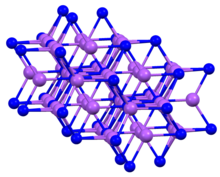
| |
| Names | |
|---|---|
| Other names
sodium phosphide,
trisodiophosphine | |
| Identifiers | |
3D model (JSmol)
|
|
| ChemSpider | |
| ECHA InfoCard | 100.031.834 |
| EC Number |
|
PubChem CID
|
|
| UNII | |
| |
| |
| Properties | |
| Na3P | |
| Molar mass | 99.943 g/mol |
| Appearance | red crystals |
| Density | 1.74 g/cm3 |
| Melting point | 650 °C (1,202 °F; 923 K) |
| hydrolysis | |
| Solubility | insoluble in liquid CO2 |
| Structure | |
| hexagonal a = 4.9512 Å c = 8.7874 Å | |
| around P 5 near neighbours, trigonal bipyramid [1] | |
| Related compounds | |
Other anions
|
sodium arsenide sodium nitride |
Other cations
|
aluminium phosphide lithium phosphide potassium phosphide |
Except where otherwise noted, data are given for materials in their standard state (at 25 °C [77 °F], 100 kPa).
| |
Sodium phosphide is the inorganic compound with the formula Na3P. It is a black solid. It is often described as Na+ salt of the P3− anion.[2] Na3P is a source of the highly reactive phosphide anion. It should not be confused with sodium phosphate, Na3PO4.
In addition to Na3P, five other binary compositions of sodium and phosphorus are known: NaP, Na3P7, Na3P11, NaP7, and NaP15.[3]
- ^ Dong, Y; Disalvo, F.J (2005). "Reinvestigation of Na3P based on single-crystal data". Acta Crystallographica Section E. 61 (11): i223–i224. Bibcode:2005AcCrE..61I.223D. doi:10.1107/S1600536805031168.
- ^ Yunle, G; Fan, G; Yiate, Q; Huagui, Z; Ziping, Y (2002). "A solvothermal synthesis of ultra-fine iron phosphide". Materials Research Bulletin. 37 (6): 1101–1106. doi:10.1016/S0025-5408(02)00749-3.
- ^ Inorganic Chemistry, Egon Wiberg, Arnold Frederick Holleman Elsevier 2001 ISBN 0-12-352651-5